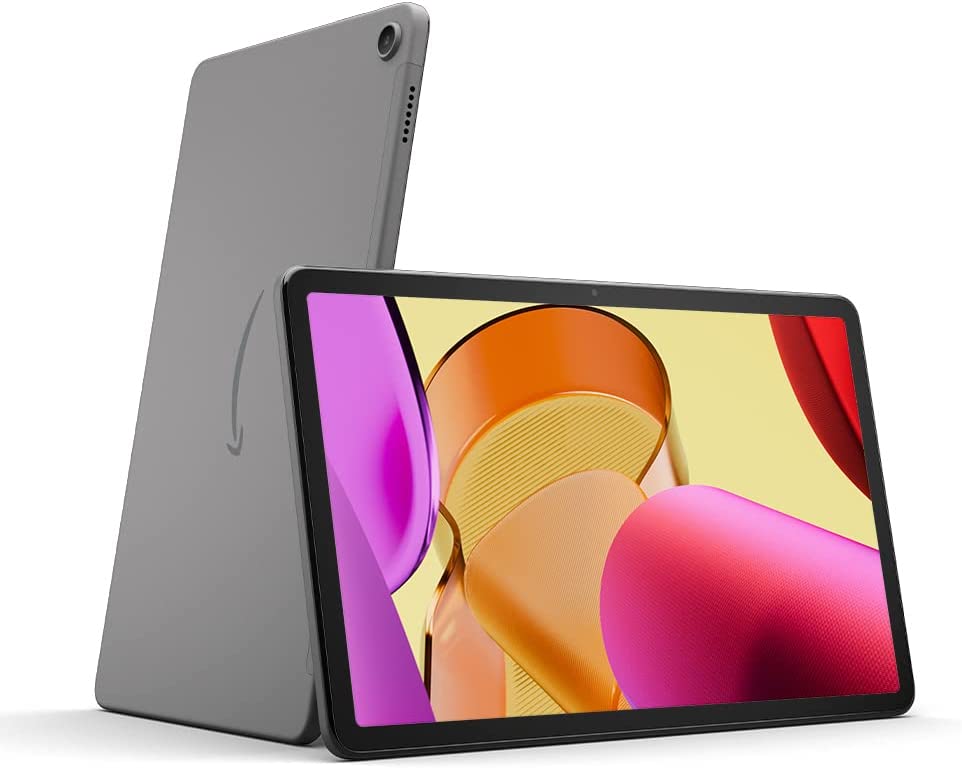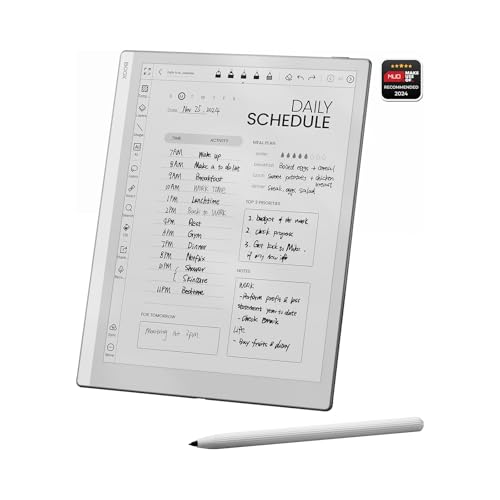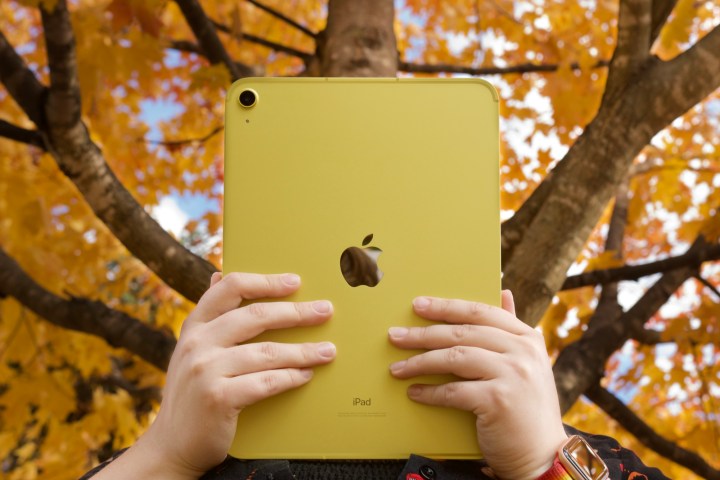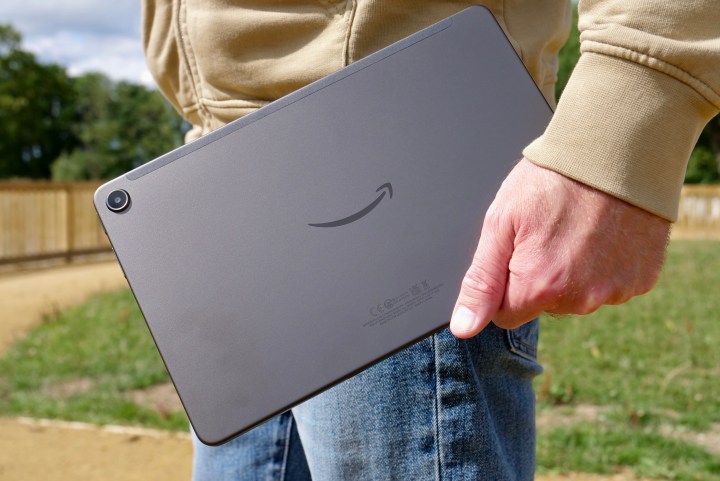Even the best smartphones still have relatively small screens. After all, they can only get so big before they're no longer practical or pocketable. There are some great folding phones that try to give you the best of both worlds, but these are pricy options and often make compromises you're unwilling to live with. If you're looking for a larger canvas for reading, sketching, gaming, or just about anything else, you're likely much better off going with a tablet. This lets your smartphone keep doing what it does best — being portable, taking great pictures, and offering solid battery life — while giving you an alternative for those times when you need more screen real estate.
However, choosing the right tablet can be tricky. People use tablets in different ways, so there are dozens of options on the market to address these myriad needs. We know how hard it can be to wade through them all and find the one that works best for your use case and budget, so we've done the legwork for you, reviewing dozens of tablets across the entire spectrum to compile a list of the top eight for all walks of life.
Our top choice is still the iPad Air (2024), which delivers exceptional performance and value and strikes the right balanc for most folks. Of course, your needs might be different, so we have quite a few others here, including more affordable options, travel-friendly companions, and even one with a massive 14.6-inch screen for immersive entertainment. There are also powerful tablets that can almost replace a laptop, plus a niche e-ink tablet for those who lean more toward an e-reader style and want something that's easy on teh eyes.
Looking for some sweet tablet deals? Check out our lists of the best iPad deals and the best tablet deals.









The best tablet overall
Apple iPad Air (2024)
- Thin, light, and portable
- Huge power reserves
- 128GB minimum storage
- Great for games and video
- Good for general work with a keyboard
- 60Hz screen
- Slow charging
- Little incentive to upgrade
| Specification: | |
| Processor | Apple M2 |
| Display | Liquid Retina LED 11-inch: 2360 x 1640 resolution at 264 pixels per inch 13-inch 2732 x 2048 resolution at 264 pixels per inch |
| Dimensions | 11-inch: 247.6 x 178.5 x 6.1 mm (9.74 x 7.02 x 0.24 inches) 13-inch: 280.6 x 214.9 x 6.1 mm (11.04 x 8.46 x 0.24 inches) |
| Weight | 11-inch: 462g (1.02 lbs) 13-inch: 617-618g (1.36 lbs) |
| Storage capacities | 128GB, 256GB, 512GB, 1TB |
| Memory | 8GB |
| Operating system | iPadOS 18 |
| Colors | Space Gray, blue, purple, Starlight |
| Price | From $599 |
Why should you buy this? It offers everything most people want in an Apple tablet — and none of the extras the more costly iPad Pro includes.
Who's it for? Anyone with an older iPad should consider this version. It's still our favorite of the year -- the Goldilocks of iPad.
Why we picked the iPad Air (2024):
Are you in the market for an iPad, but want something more than the basic model and less costly than the feature-rich iPad Pro? If so, you're likely not alone. This common scenario brings us to the iPad Air (2024), which strikes the perfect balance in the iPad lineup. It offers a choice of screen sizes, impressive power, and extensive versatility — all at a price in the three-figure range. It's still our top tablet pick for the year.
The iPad Air (2024) is an outstanding device that meets the needs of most users, including those who might consider it a laptop replacement, provided they don't require extensive computing capabilities. Given the significant price jump to the M4 iPad Pro and the fact that the 10th-generation iPad is approaching three years since its last update, the iPad Air (2024) is still the ideal choice for most folks.
However, if you already own an iPad Air or iPad Pro from the last five years, there are fewer reasons to hold off on an upgrade. The M2 iPad Air (2024) still lacks a 120Hz screen, and the M1 chip in the older Air tablets remains highly capable. Additionally, the last iPad Pro models utilize the M2 chip, and even the 4th-generation iPad Air supports the Magic Keyboard, while all these devices run the same software. Unless you need more storage, there isn't a compelling reason to upgrade from your existing iPad Air or iPad Pro.
If you’re looking for your first iPad or want to upgrade from a significantly older model, the iPad Air (2024) is superb and definitely our pick among the 2025 iPad offerings. Aside from its lack of a 120Hz ProMotion screen, you couldn’t ask for anything more.


The best Android tablet
OnePlus Pad 2
- Beautiful build and light form factor
- Reliable stylus and keyboard
- Great six-speaker setup
- 67W fast charging
- Plenty of silicon firepower
- Beautiful 144Hz display
- Feature-rich OxygenOS experience
- Lack of dust and water resistance
- No cellular connectivity support
- OxygenOS could use some refinement
| Specification: | |
| Processor | Qualcomm Snapdragon 8 Gen 3 |
| Display | 12.1 Inch LCD, 2120 x 3000 resolution at 304 pixels per inch |
| Dimensions | 268.66 x 195.06 x 6.49 mm (10.58 x 7.68 x 0.26 inches) |
| Weight | 584g (1.29 lbs) |
| Storage capacities | 128GB, 256GB |
| Memory | 8GB, 12GB |
| Operating system | Android 14 with OxygenOS 14.1 |
| Colors | Nimbus Gray |
| Price | From $550 |
Why should you buy this? It's the best that Android tablets have to offer.
Who’s it for? Anyone who needs a medium-sized tablet with creative, professional, and casual options.
Why we picked the OnePlus Pad 2:
The OnePlus Pad 2 makes a strong case for itself as the top-tier Android tablet in 2025. Its combination of Qualcomm's fastest processor, excellent accessories like a high-quality keyboard and stylus, and promising software features creates a compelling package. The build quality is superb, with standout speakers adding to the premium experience. However, the Pad 2 is not without its drawbacks.
While the software is generally enjoyable, it lacks the polish of iPadOS 18, particularly in-app optimization and overall refinement. Samsung's Galaxy Tab series also presents a challenge, offering features like DeX mode, superior window management, and longer software support. The absence of an IP rating for dust and water resistance on the OnePlus Pad 2 is another notable omission.
Ultimately, the best tablet choice depends on your individual needs and ecosystem preferences. Users of the iPhone might find the iPad Air or a refurbished iPad Pro more appealing. Samsung enthusiasts have excellent options in the Galaxy Tab S9 FE or Tab S8 Plus. However, the OnePlus Pad 2 is a powerful and well-rounded device that delivers a great Android tablet experience, especially for those already using a OnePlus phone.


The best value tablet
Apple iPad (2022)
- Updated, modern design
- Wonderfully vibrant colors
- Larger display is fantastic
- A14 chip is plenty powerful
- Strong battery life
- USB-C is finally here
- The headphone jack is gone
- Non-laminated screen
- Apple Pencil situation is a mess
- Huge price increase
| Specification: | |
| Processor | Apple A14 Bionic |
| Display | 10.9-inch Liquid Retina LED, 2360 x 1640 resolution at 264 pixels per inch |
| Dimensions | 248.6 x 179.5 x 7mm (9.79 x 7.07 x 0.28 inches) |
| Weight | Wi-Fi: 477g (1.05 lbs) Wi-Fi + Cellular: 481g (1.06 lbs) |
| Storage capacities | 64GB, 256GB |
| Memory | 4GB |
| Operating system | iPadOS 18 |
| Colors | Silver, blue, pink, yellow |
| Price | From $349 |
Why should you buy this? It's simply the best value tablet you can buy.
Who’s it for? Anybody who wants a tablet that can handle all the basics, without spending too much money.
Why we picked the iPad (2022):
The Apple iPad (2022) marks one of the most significant updates to the baseline iPad in years. With a new design, a larger screen, a more powerful chipset, and an improved camera system, it promises to be the budget tablet many of us have been waiting for.
The latest standard-size iPad has a lot to appreciate. It features a spacious display, impressive performance, and stunning color options. The new design and colors are striking, the iPad operates quickly, and the battery life is dependable.
However, it has some drawbacks that are common with budget tablets. For example, it includes a non-laminated display and only supports the Apple Pencil (USB-C), not the Apple Pencil Pro. These minor shortcomings can become more noticeable compared to other iPads in Apple’s lineup.
If you're looking for an iPad — perhaps for your kids, as a family tablet, or for watching YouTube videos on a budget — the iPad (2022) is an excellent choice.
However, if you have a larger budget and want a more capable device, consider the iPad Air (2024). It offers Apple’s much more powerful M2 chip, which features a dedicated media engine, a higher-quality laminated display, a better chipset, and compatibility with the Apple Pencil Pro.


The best value Android tablet
Amazon Fire Max 11
- Great screen for video
- Keyboard feels good to type on
- 10-hour-plus battery life
- Useful kickstand case
- Sparse app store
- Slow charging
| Specification: | |
| Processor | Mediatek MT8188J |
| Display | 11-inch IPS LCD, 2000 x 1200 resolution at 213 pixels per inch |
| Dimensions | 259.08 x 163.58 x 7.62mm (10.2 by 6.44 by 0.3 inches) |
| Weight | 499g (1.1 lbs) |
| Storage capacities | 64GB, 128GB |
| Memory | 4GB |
| Operating system | Android 11, Amazon FireOS 8 |
| Colors | Gray |
| Price | From $230 |
Why should you buy this? It's an affordable Android tablet that will give you the best bang for your buck.
Who’s it for? Folks looking for an affordable Android tablet that handles all the basics well.
Why we picked the Amazon Fire Max 11:
The Amazon Fire Max 11 is a basic little tablet that will get the job done if you are on a tight budget. Design-wise, the Fire Max 11 isn't going to be a standout in any way, but that's fine. The 11-inch size, combined with the simple design, makes it lightweight and incredibly easy to use.
The MediaTek MT8188 octa-core processor is not the absolute best out there, but it handles basic tasks and even casual games just fine. It also has 4GB of RAM, so it's not going to be able to handle super-intensive tasks, but if you need something with more power, then you wouldn't be looking at something this cheap either. For the average person, the specs of the Fire Max 11 are fine for general use.
Plus, this Amazon Fire Max 11 can be used with separate accessories, like a keyboard and stylus, making it a fantastic value if you want to be more productive.
However, the Fire Max 11 won't come with the Google Play Store by default — you'll have to add that manually later on. The Fire Max 11 uses a version of Fire OS that is based on Android 11, so it's a little outdated. It comes with Amazon's own curated app store, so the app choice may be a bit more limited than other Android tablets. But there are ways to get the Google Play Store on the Fire Max 11.
The Amazon Fire Max 11 is far from perfect. Software and app availability are a bit disappointing, and the separate stylus has limited use (it doesn't come with a sketching app by default). It has a 7,500mAh battery that's decent, but the included charging block has a max charging speed of 9W. The Fire Max 11 only supports up to 15W of charging anyway, so even if you use a faster charging brick, it will take around three hours to get a full charge — you better not need to charge up before you head out!
But with battery life being around 10 hours, it should be fine for a full workday, then just charge it up overnight. For the price, the Fire Max 11 is a pretty strong value.


The best small tablet
Apple iPad mini (2024)
- Pocketable size and gleefully light
- Better aspect ratio than other iPads
- Sharp and colorful display
- A17 Pro silicon is plenty powerful
- Battery life doesn't disappoint
- Screen should be brighter
- Apple Intelligence is still half-baked
| Specification: | |
| Processor | Apple A17 Pro |
| Display | 8.3-inch Liquid Retina LED, 2266 x 1488 resolution at 326 pixels per inch |
| Dimensions | 195.4 x 134.8 x 6.3 mm (7.69 x 5.3 x 0.25 inches) |
| Weight | Wi-Fi: 293g (0.65 lbs) Wi-Fi + Cellular: 297g (0.65 lbs) |
| Storage capacities | 128GB, 256GB, 512GB |
| Memory | 8GB |
| Operating system | iPadOS 18 |
| Colors | Blue, purple, Starlight, Space Gray |
| Price | From $499 |
Why should you buy this? You want a premium tablet with a smaller footprint that's particularly great for note-taking and reading.
Who’s it for? Anyone who wants a small but powerful tablet.
Why we picked the iPad mini (2024):
The iPad mini seems to be running on a nearly three-year update cycle, and thankfully 2024 brought an update. The previous iPad mini (2021) was still the best small tablet on the market, but it was starting to show its age. The latest model takes everything that was great about its predecessor and breathes new life into it with a faster processor and support for the new Apple Pencil Pro.
This marks the seventh iteration of Apple's smallest tablet, although it's only the second to feature the new edge-to-edge screen design. Little has changed from the 2021 model on the outside other than a new blue color that replaces the pink. However, it's received a significant peformance boost under the hood, thanks to Apple's A17 Pro chip.
This is essentially the same chip that was used in the 2023 flagship iPhone 15 Pro and iPhone 15 Pro Max. Combined with 8 GB of RAM, that means the new iPad mini can handle all the new Apple Intelligence features and AAA console games like Assassin's Creed Mirage (technically, it's a "binned" version of the A17 Pro with one less GPU core than the one used in the iPhone 15 Pro, but we can't say we've noticed a difference).
Since Apple's resurrection of the iPad Air and iPad mini in 2019, the two tablets have offered very similar specs, differing only in size and processor. The iPad mini (2024) is no exception; it's a little sibling to the iPad Air (2024) in nearly every way, offering the same high-quality Liquid Retina display with an antireflective coating, landscape stereo speakers, 5G and Wi-Fi 6E capabilities, and full compatibility with all the features of the Apple Pencil Pro. The key difference is the larger tablet gets Apple's M2 chip versus the iPad mini's A17 Pro, but that's not as big a gap as you might think, as the A17 Pro is a newer chip, which balances things out a bit. The iPad Air (2024) slightly beats the iPad mini (2024) in benchmarks, but the two tablets perform equally well for everyday tasks. Even Final Cut Pro runs well on the iPad mini; it's the smaller screen that's constraining more than the chip.
In other words, the iPad mini (2024) gives you all the power of Apple's larger midrange tablet in a form factor that's almost pocketable. This makes it an excellent choice for casual surfing, reading e-books, and scribbling notes and simple sketches. Serious artists will want the larger canvas of the iPad Air or iPad Pro — possibly even the 13-inch versions of those — but the iPad mini with the Apple Pencil Pro or the more affordable Apple Pencil (USB-C) feels much more natural as a notepad for capturing your thoughts on the go. The downside is that there's no Smart Connector or Magic Keyboard option. Instead, you can pair it with a Bluetooth keyboard like any other iPhone or iPad, and you can even find a few keyboards among the best iPad mini cases (and it's fully compatible with iPad mini (2021) cases).


The best big tablet
Apple iPad Pro (2024)
- Sublime OLED screen
- Lovely design and build
- Top-notch speakers
- Surprisingly good battery life
- Blistering performance
- Excellent keyboard and stylus
- iPadOS is achingly lacking
- It's extremely expensive
- Pricey accessories
| Specification: | |
| Processor | Apple M4 |
| Display | Ultra Retina XDR Tandem OLED 11-inch: 2420 x 1668 resolution at 264 pixels per inch 13-inch 2752 x 2064 resolution at 264 pixels per inch |
| Dimensions | 11-inch: 249.7 x 177.5 x 5.3 mm (9.83 x 6.99 x 0.21 inches) 13-inch: 281.6 x 215.5 x 5.1 mm (11.09 x 8.48 x 0.20 inches) |
| Weight | 11-inch: 444–446g (0.98 lbs) 13-inch: 579-582g (1.28 lbs) |
| Storage capacities | 256GB, 512GB, 1TB, 2TB |
| Memory | 8GB (256GB/512GB models), 16GB (1TB/2TB models) |
| Operating system | iPadOS 18 |
| Colors | Silver, Space Black |
| Price | From $999 |
Why should you buy this? The iPad Pro is extremely powerful and offers a huge screen.
Who’s it for? Gamers, creatives, and power users.
Why we picked the iPad Pro (2024):
The M4 iPad Pro is a polarizing device, lacking any true midpoint when it comes to value. Here’s the gist: the iPad Pro is expensive. However, the 2024 model may be the first that justifies its high price.
Available in 11-inch and 13-inch displays, the latest iPad Pro is packed with impressive performance capabilities. The hardware is exceptional, and the battery life exceeds expectations. The OLED screen is outstanding, and the speakers provide excellent multimedia support. The redesigned Magic Keyboard is a nice addition, though it comes at a premium price. If you’re within the target audience from a software perspective, this device will consistently make you smile. It’s that impressive.
On the flip side, if you don't belong to that fortunate group, iPadOS can be a frustrating experience filled with usability and functional challenges. On a bad day, you might find yourself dealing with a stuck, non-resizable Google Docs window. On a good day, you may even consider ditching your laptop altogether and working exclusively on the iPad Pro.


The best big Android tablet
Samsung Galaxy Tab S10 Ultra
- Anti-reflective display tech
- Solid battery life
- Great performance
- Included S Pen
- Some useful Galaxy AI features
- Too big to be portable
- Android is poorly optimized for big screens
- Very, very expensive
| Specification: | |
| Processor | MediaTek Dimensity 9300 Plus |
| Display | 14.6-inch Dynamic AMOLED 2X, 1848 x 2960 resolution |
| Dimensions | 326.4 x 208.6 x 5.4mm (12.85 x 8.21 x 0.21 inches) |
| Weight | 718g (1.58 lbs) |
| Storage capacities | 256GB, 512GB, 1TB |
| Memory | 12GB, 16GB (1TB model) |
| Operating system | Android 14, OneUI 6.1 |
| Colors | Gray, silver |
| Price | From $1,200 |
Why should you buy this?: You get a lot for much less than most of the competition.
Who's it for: Anyone who wants a lower-cost tablet that's still offers a huge display should consider this.
Why we picked the Samsung Galaxy Tab S10 Ultra:
You might wonder whether a 14-inch tablet is necessary. Given the popularity of this size in laptops, a tablet with similar dimensions could be quite appealing. After all, bigger often means better, right?
To answer this question, it's important to consider if any Android tablet is truly worth purchasing. The challenges faced by the Galaxy Tab S10 Ultra aren’t due to Samsung, but are inherent to the Android system itself. If you can accept these limitations, then the Galaxy Tab S10 Ultra offers the best large-screen Android experience available.
If you’re looking for a tablet primarily for media consumption and prioritize screen space, this is an excellent choice. It also works well as a companion device if you own a Samsung phone or laptop. However, if you hope to use it as a laptop replacement or expect a seamless experience comparable to the iPad Pro, you might be disappointed. While the Galaxy Tab S10 Ultra excels at multitasking, the software has limitations that it cannot completely overcome.
Overall, we enjoyed using the Galaxy Tab S10 Ultra. It may not be the best for typing on the couch, but the large screen is incredibly useful. It’s perfect for use in the kitchen or for entertainment purposes when you're away from home. If this matches how you use a tablet, the Galaxy Tab S10 Ultra could be the right choice for you. Just keep its limitations in mind, and you’ll find it to be a fantastic device.


The best e-ink tablet
Onyx Boox Go 10.3
- E-ink screen is easy on the eyes
- Solid build quality
- Crisp display
- Highly customizable
- Excellent battery life
- Reflective e-ink screen can't be used in the dark
- Runs Android 12
- Not suitable for media consumption
| Specification: | |
| Processor | 8-core, 2,4 GHz |
| Display | 10.3-inch E Ink Carta Plus 2480 x 1860 resolution at 330 ppi |
| Dimensions | 235 × 183 × 4.5mm (9.25 x 7.20 x 0.18 in) |
| Weight | 365g (0.8 lbs) |
| Storage capacities | 64GB |
| Memory | 4GB |
| Operating system | Android 12 |
| Colors | White |
| Price | $399 |
Why should you buy this?: An e-ink display provides an experience that's easy on the eyes.
Who's it for: Anyone who wants an e-reader with a tablet experience.
Why we picked the Onyx Boox Go 10.3:
Most tablets have backlist IPS or OLED displays that make them great picks for a wide variety of media and even gaming. However, the Onyx Boox Go 10.3 offers an experience that's designed for those who lean more toward e-readers but don't want to sacrifice all the capabilities of a tablet to get there .
Key to the Boox Go is its 10.3-inch e-ink display. It's monochromatic, to be sure, but it also offers a crisp 2480 x 1860 resolution at 300 pixels per inch. Only the OnePlus Pad 2 matches it among full-sized tablets. The Boox Go is also the thinnest and lightest tablet on our list, coming in at 4.5mm — 0.6mm below Apple's "impossibly thin" M4 iPad Pro — and only 365 grams.
To be clear, this isn't a tablet for watching Netflix or running graphically intensive games and apps, but it's also much more than an e-reader. The included stylus lets you sketch, take notes, or even just scribble on documents, and it provides a nearly lag-free experience when doing so. There's also plenty of customization that lets you adjust the e-ink refresh rates to minimize ghosting, plus tweak the DPI, set animation filters, toggle de-aliasing of fonts, and more.
It also runs Android with full access to the Play Store. It ships with Android 12, but Onyx has promised updates through to Android 15. You can download productivity apps like Gmail, Google Calendar, and Google Meet, play YouTube videos (in black and white), or listen to podcasts — the speakers are surprisingly clear and loud. It also multitasks and supports split-view mode like any other Android tablet, but don't expect the e-ink screen to be buttery smooth. It gets the job done, but the display technology is only capable of so much. There's also no backlight or frontlight here, so the Boox Go 10.3 is very much a tablet for use outdoors or in a well-lit room. The build quality is such that we wouldn't have any qualms about taking it on an outdoor excursion, and the beauty of e-ink is that it thrives in sunlight without the glare problems that plague most tablets with backlit screens.

Frequently Asked Questions
Yes, you can indeed print from a tablet. Check out our guides on how to print from an iPhone and how to print from an Android tablet for all the details you need.
Yes, you can make phone calls on a tablet, but you will need to be connected to the internet. You can either connect to Wi-Fi, which every tablet can do for free, or if you need to make calls while you're out and about beyond the reach of a Wi-Fi network, buy a tablet with cellular support and space for a SIM card. Just bear in mind if you go the SIM card route, you will also have to sign up for a service plan of some kind. Some carriers offer special plans for tablets, but keep in mind that most tablets — and all of Apple's iPads — only support a SIM card for data use, not traditional cellular calling or even SMS/MMS messaging.
You can use FaceTime on an iPad, but there are lots of good alternative video chat apps that work with Android tablets or iPads. Many of them allow you to make audio calls as well. However, the person you want to call usually has to have the same app. Some apps, like Skype, also allow you to call regular landline or mobile phone numbers, but you'll generally have to pay per minute or get a subscription. A good app that will work on Android tablets or iPads that gives you a free number for calling, text messages, and voicemail is Google Voice, but it only works in the U.S.
If you're interested in this option for a business, then you might also consider one of the best VoIP (Voice Over Internet Protocol) services.
Yes, you can send text messages from a tablet. If you have an iPad then you can use iMessage, which can connect to your phone to send standard SMS messages and iMessages alike. There are lots of great text messaging apps that work on Android or iOS. You could also use Google Voice if you are based in the U.S. as it gives you a free number for calls and text messages.
What to consider when buying a tablet
One of the most critical factors when picking a tablet is the operating system. However, beyond this, you’ll also want to consider the display size, resolution, and type. The display quality is paramount and can make a significant difference in the clarity and crispness of images.
The tablet’s processor and RAM are also important in determining your tablet’s overall performance and speed. Also consider the connectivity options you require in your tablet — whether Wi-Fi is okay or you also want 5G connectivity. USB-C and Bluetooth are fairly standard these days, but it's best to double-check; ports like HDMI and microSD are less common. Good battery life is crucial if you use your tablet on the go or away from a power source, as is fast charging if you plan to take long trips and don't want to wait for it to charge up overnight.
Which operating system is best for you?
If your top consideration is entertainment, and you’re likely to use a lot of apps and games, then we recommend Apple’s iPadOS over Android. There are a lot of polished apps made specifically for the iPad and you have access to all the top subscription services and an extensive content store. It’s also slick and accessible, so anyone can come to grips with it quickly.
Android has a larger selection of free apps and games, though they’re generally less polished, which might be a trade-off you’ll accept. Things are a little complicated by manufacturer UIs, or in the case of Amazon, forked versions of the platform. They can delay Android updates and make the user experience quite different. Amazon’s tablets, for example, run a version of Android called Fire OS and they initially only have access to the limited subset of apps and games that are available in the Amazon Appstore, not the full list that you’ll find in Google’s Play Store.
If you like the idea of accessing the same apps you have on your Windows PC, and you want a business device that ties seamlessly into your Microsoft services, then a tablet running Windows 11 is going to be tempting. It’s powerful, but it’s also relatively expensive to get decent hardware for a good user experience. If you’re not a business user, or you don’t need to run Windows-only apps, it may be overkill.
Storage capacity
How much storage you need will depend entirely on how you plan to use your tablet. A 128GB or 256GB tablet should be more than adequate if you're only looking to read books, surf the web, and run a few productivity apps and casual games. If you plan to watch video, you may find a 5G-connected tablet with a virtually unlimited data plan is a better investment than paying for more storage. Conversely, buying more storage to download and keep your movies and TV shows offline is a better way to go if you're frequently off the grid or don't want to be saddled with another monthly data plan.
If you're tablet has a microSD slot, you can always add more storage later. However, many tablets, like Apple's popular iPads, don't come with expandable storage. In this case, we recommend buying one capacity higher than what you think you need, as it's much harder to change your mind later.
How much are you willing to spend?
In some respects, the most crucial factor is considering your budget and how much you are willing to spend. There are tablets for every budget – from cheaper models to high-end options.
If money is no object, you really can't go wrong with Apple's flagship M4 iPad Pro. However, that delivers far more than most tablet users need. There are plenty of other options for those who want to keep more of their hard-earned money in their wallets, such as Apple's entry-level iPad (2022) and Amazon's Fire Max 11. These will both handle all your media consumption needs on a budget.
How we tested
The tablets we test serve as our daily drivers, so we use them extensively to put them through their paces. That means watching movies, gaming, testing out lots of apps, reading, working on them, and even taking photos and shooting videos with them (which is impossible to do without looking stupid). We love new, innovative features, but we can also appreciate classic design done well. Ultimately, we look for tablets that will fulfill the needs of most people, so their ability to serve up entertainment is paramount.
Why trust us
Our team here at Digital Trends has well over a decade of experience with tablets and related technologies. We reviewed the original Apple iPad in 2010 and we've been researching, testing, exploring, and reviewing hundreds of tablets since then. We've collectively used nearly every modern tablet ever made, and the ones we recommend here are the same ones we use ourselves and tell our friends and family about.
We know tablets inside and out — and then some, and we're passionate about the technology. We use these tablets out in the real world for many of the same things that you, our readers, do every day. We've used our favorite tablets to binge-watch Netflix, read New York Times best-sellers, play everything from casual to AAA console games, draw and sketch, and even write many of the articles that you enjoy here at Digital Trends. If a tablet doesn't work for us, we won't use it and we also won't shy away from objectively telling you why it failed to meet our expectations. We have no vested interest in any of these products other than picking the very best ones for our needs, and the products we recommend to you are the same ones we use and love every day.






